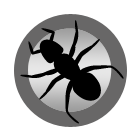 Ants are social insects that live together in colonies, ranging from a dozen or so individuals to tens of thousands. They are typically black, brown, red or yellow in colour and are easily identified by their three distinct body parts (head, thorax and abdomen); clearly defined waist; elbowed antennae and compound eyes.
Ants are social insects that live together in colonies, ranging from a dozen or so individuals to tens of thousands. They are typically black, brown, red or yellow in colour and are easily identified by their three distinct body parts (head, thorax and abdomen); clearly defined waist; elbowed antennae and compound eyes.
Types of Ants
Across Australia, there are approximately 3000 known species of ants however only a few common species are considered pests in urban areas. Throughout Joondalup and the northern suburbs of Perth, most ant problems are caused by:
Argentine Ants
Small brown ant, 1.5 – 3.0mm long. Mostly found on exposed soil or rotting logs. May be seen indoors in wet weather. Attracted to sweet foods.
Black House Ants
Small black ant, 2.5 – 3.00mm long. Mostly found outside (against paths or in rockeries). Can be found in cavity walls and subfloor areas. Attracted to sweet foods.
Bull Ants
Large red or black ant, 18 – 20mm long. Mostly found outside on exposed soil or under rocks, logs, etc. Rarely found indoors. Can inflict a painful sting.
Coastal Brown Ants
Small brown ant, 1.5 – 2.5mm long. Sometimes found around paths or rockeries, although often found in buildings in cavity walls and around architraves and skirtings. Attracted to foods containing meat, fats or grease.
White Footed House Ants
Small black ant, 2.5 – 3.0mm long. Found both indoors and outside. Indoors, mostly located in cavity walls, around architraves and skirtings, in and behind built-in cabinets (eg. kitchen cupboards). Outdoors, mostly located around paths or rockeries. Attracted to both meat-based and sweet foods.
Problems caused by Ants
For most people, ants become a problem when they enter buildings in search of food and water, or when they build their nests in buildings or gardens
The majority of ants are scavengers and are attracted to a wide range of foods, including those containing sugars, proteins, fats or oils. Typically, ants will forage alone for food or water however when a food source is found, they will return to the nest to recruit additional ants to help gather the food. This can result in large numbers of ants appearing in a short period of time.
Ants can also cause problems when they build their nests in gardens or buildings. In outdoor areas, nesting activity can result in small mounds of soil being deposited on paving, brickwork, in garden beds or potted plants. This is usually considered more of a nuisance than a problem, however extensive nesting activity can sometimes cause soil to become soft under the surface, leading to cracks in older concrete pathways or unevenness in paving.
Indoors, ants will build their nests in walls, foundations, and other small cracks and crevices. Ants will not generally cause structural damage to buildings however swarming may occur within premises which may cause concern for occupants.
Although uncommon, ants may also present a health risk. Scientists have discovered ants are capable of carrying diseases such as dysentery and smallpox on their backs, as well as salmonella bacteria. As ants commonly scavenge in food areas, garbage areas and gardens, their potential for transmitting disease should not be overlooked. In addition, some ants may bite or give a painful sting.
If you have concerns about ants, please call WA Pestsaway Joondalup on 0419 374 374

